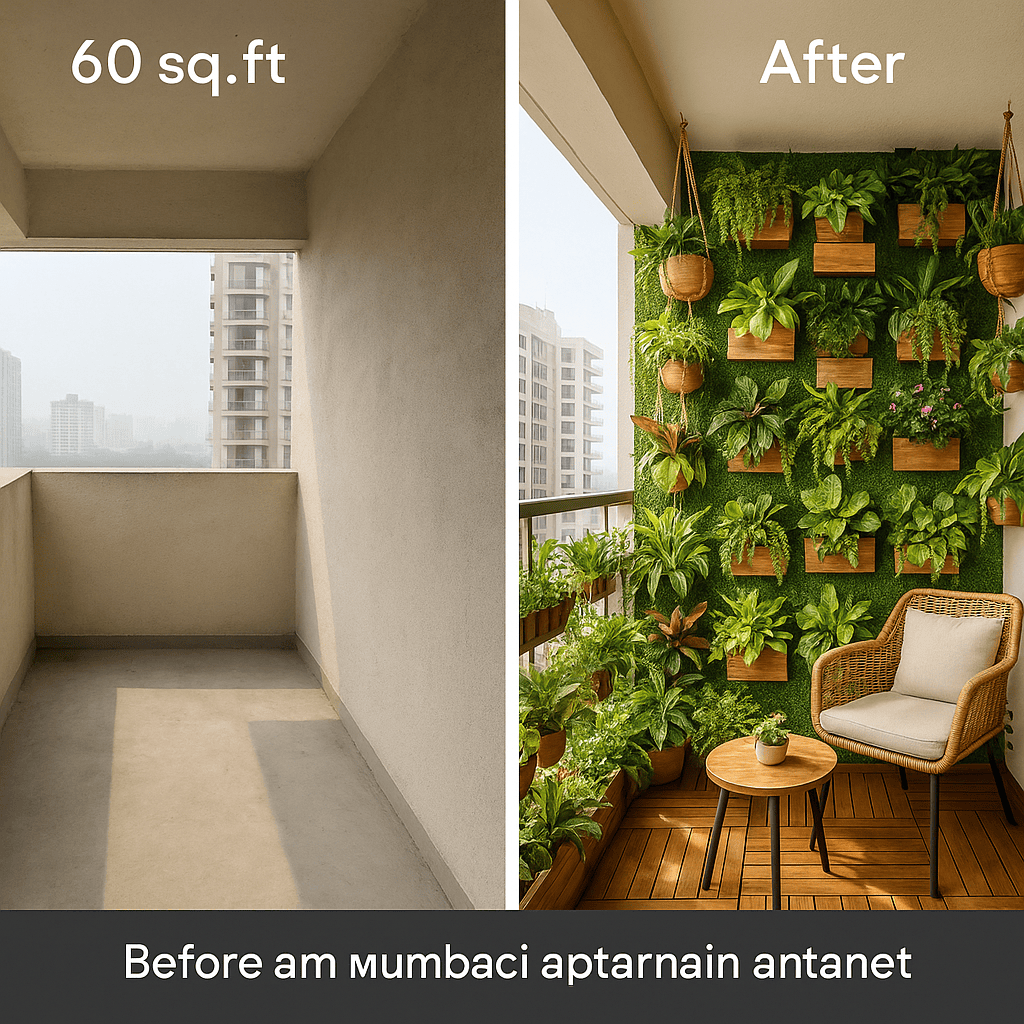
Honestly, I never thought I’d become the guy obsessing over plants. But here we are, three years later, and my Mumbai apartment balcony has become the talk of the building.
It all started when I moved into this tiny 2BHK in Andheri. The balcony was barely 60 square feet – more like a glorified storage closet with a view. My mom kept saying, “Beta, at least grow some tulsi,” but I figured there was no space for anything green.
Then my neighbor’s aunt showed me her setup. This woman had transformed her equally small balcony into what looked like a mini jungle. Fresh mint for her evening chai, cherry tomatoes for salads, even green chilies that put the market ones to shame.
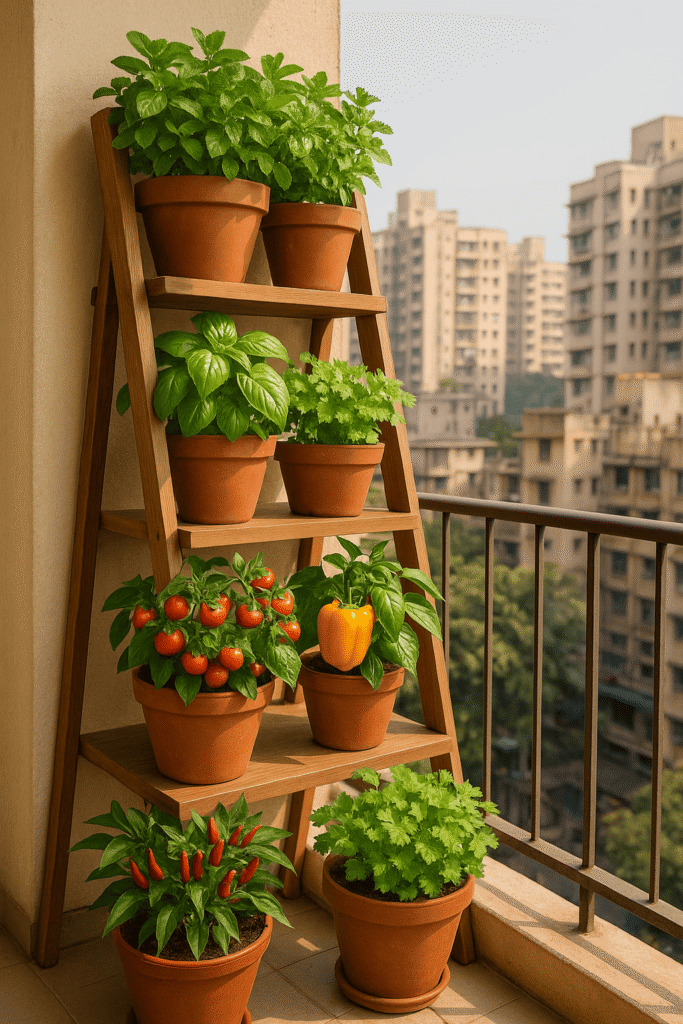
The secret? She’d figured out how to build a vertical garden planter that used every inch of vertical space instead of fighting for floor area.
I was sold. Three years later, I’m the guy giving plant advice to the entire society WhatsApp group. My grocery bills have dropped by ₹650 per month, and honestly, there’s something deeply satisfying about plucking your own mint leaves at 6 PM.
If you’re dealing with similar space constraints, our detailed guide on DIY Mumbai balcony vertical garden setup walks you through space-specific challenges I faced in my own apartment.
What Exactly is a Vertical Garden Planter
Think of it like this – instead of spreading plants horizontally like a traditional garden, you stack them vertically like floors in a building. It’s the apartment living solution for plant lovers.
The concept is simple: use walls, railings, or standalone structures to create growing space upward instead of outward. In my 60 sq ft balcony, I now fit 25+ plants where I could barely manage 6-7 floor pots before.
Here’s why this works so well for Indian apartments:
Space magic: More plants in less floor area (obvious win)
Natural cooling: During Mumbai summers, my balcony runs 15-20°C cooler than my neighbor’s bare concrete space
Monthly savings: I calculated ₹650+ saved on herbs and vegetables every month
Society approval: Most building managements are fine with portable vertical systems
Easy access: No bending down to tend plants – everything’s at a comfortable height
The best part? You can start small with just 3-4 containers and expand as you get comfortable. I learned this after making the mistake of going too big initially and overwhelming myself during the first monsoon season.
There are three main approaches that work in Indian conditions:
Tower systems – Containers stacked on top of each other (looks neat, very stable)
Tiered planters – Ladder-style arrangement (my personal favorite for beginners)
Wall-mounted systems – Maximum space saving but needs strong walls
If you’re worried about dealing with our extreme weather, check out our tested list of best plants for terrace gardens in India that actually thrive in 45°C heat and monsoon humidity.
Planning Your Setup (The Mistakes I Made So You Don’t Have To)

Before you get excited and start buying stuff, let me save you the ₹3,000 I wasted in my first year by planning this properly.
Location Scouting in Your Apartment
I spent a full day with a notebook tracking sun patterns on my balcony. Sounds nerdy, but this one step prevented so many future headaches.
Sunlight needs breakdown:
Vegetables (tomatoes, chilies, brinjal): Need 6+ hours direct sun – your south or west-facing balconies
Herbs (tulsi, pudina, dhania): Happy with 4-6 hours – east-facing balconies are perfect
Leafy greens (palak, methi): Can manage with morning sun, afternoon shade
The mistake I made? Putting sun-loving tomatoes in a shaded corner because it “looked better.” They never flowered.
Weight and safety stuff:
Indian apartment balconies handle 150-200 kg per square meter according to standard building codes. A loaded vertical garden weighs about 30-50 kg total – you’re completely safe.
But always inform your building management. Even portable systems. Trust me, it’s better to get permission than deal with complaints later.
For detailed location planning specific to Mumbai apartments, our Mumbai apartment vertical gardening compliance guide covers society rules and positioning strategies.
Starting Small (Seriously, Start Small)
I recommend beginning with a 3-4 container setup. You can always expand once you figure out the watering routine and see what works in your specific conditions.
Choose designs where you can add more levels later. The modular approach saved my sanity during the learning phase.
Real Budget Breakdown (No Hidden Costs)
Here’s exactly what I spent, tested across three different setups over three years:
| What You’re Buying | Budget Route (₹) | Good Quality (₹) | Premium (₹) | What I’d Choose Now |
|---|---|---|---|---|
| 4 containers | 800-1,200 | 1,500-2,400 | 3,000-4,500 | Good quality |
| Potting soil | 400-600 | 800-1,200 | 1,500-2,100 | Good quality |
| Support frame | 600-1,000 | 1,200-1,800 | 2,400-3,600 | Budget works fine |
| Basic tools | 400-750 | 1,000-1,500 | 1,800-3,000 | Budget works fine |
| Total | ₹2,200-3,550 | ₹4,500-6,900 | ₹8,700-13,200 | ₹3,900-5,400 |
Local Alternatives That Actually Work Better
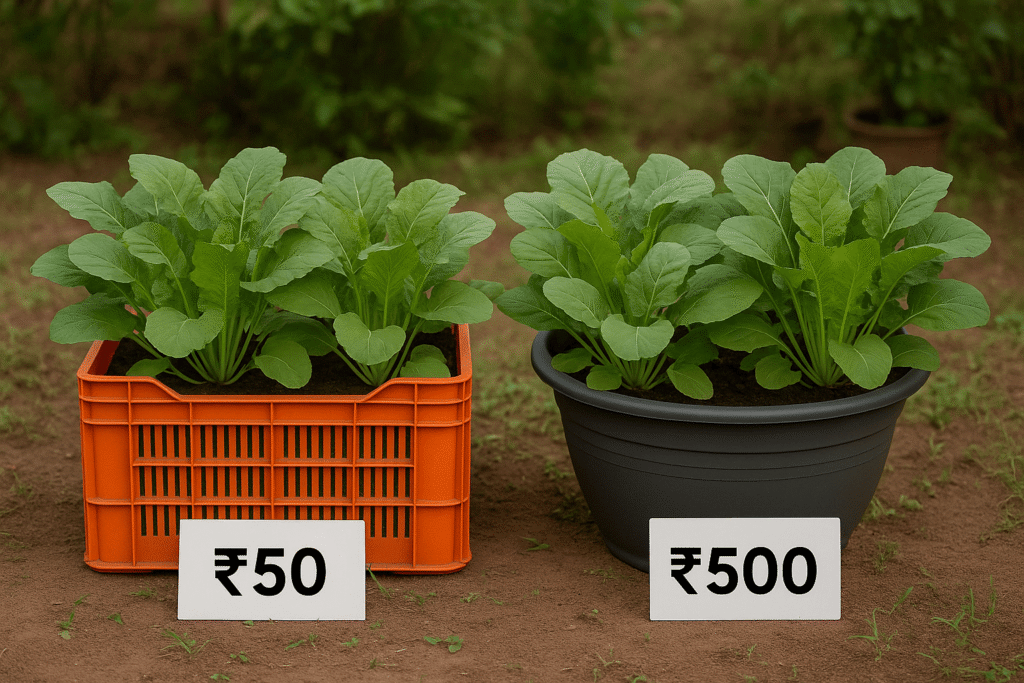
Instead of fancy imported stuff, I discovered these local alternatives that work just as well (sometimes better):
Plastic vegetable crates: ₹50-100 each from your local sabzi mandi. I’ve been using the same ones for two years – still going strong.
Coconut coir: Available at any local nursery for ₹40-60 per kg. Way better than expensive imported peat moss for our humidity.
Bamboo supports: Local bamboo costs ₹200-400 for a complete frame. Looks better than metal and handles monsoon winds perfectly.
Recycled bottles: 2-liter bottles become perfect self-watering systems for weekend trips.
Weekend nursery tip: Local nurseries offer 10-20% discounts on bulk purchases if you go on Sunday mornings.
Step-by-Step Construction (Exactly How I Built Mine)
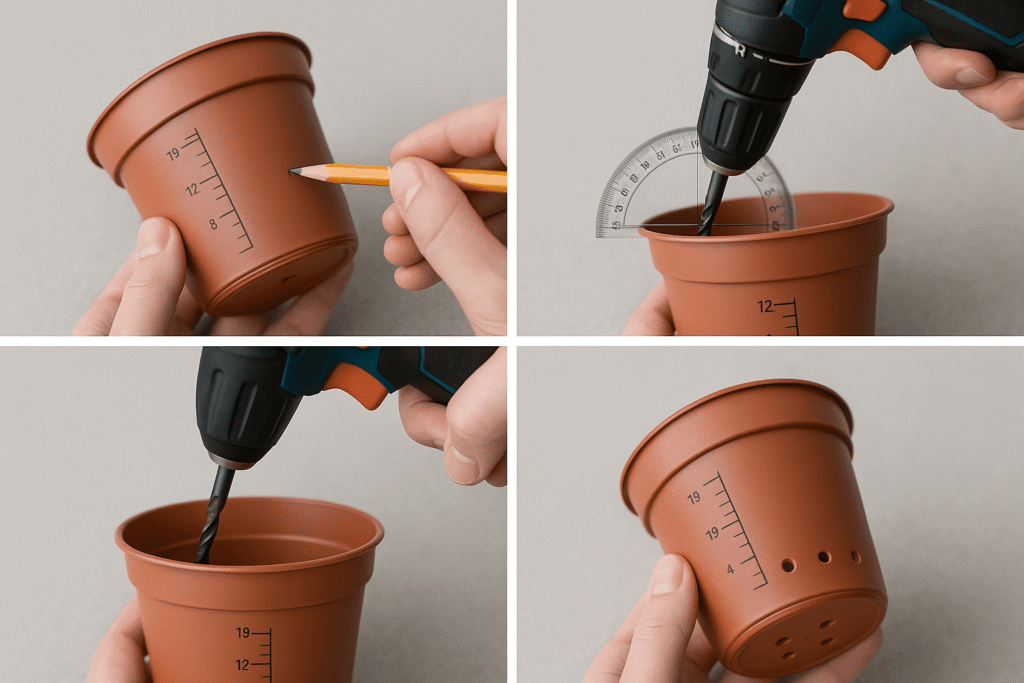
This is the exact process I followed for my current setup that’s survived three monsoons and two Delhi-level summer heatwaves.
Step 1: Container Prep (The Foundation)
Why drainage matters: In my first year, poor drainage killed ₹1,500 worth of plants during one particularly heavy monsoon week. Never again.
Tools needed:
- Electric drill with ¼ inch bit
- Measuring tape
- Marker
The process:
- Mark drilling points every 4 inches across the bottom
- Drill at a 45-degree angle (prevents clogging with soil)
- Pour water test – should drain completely within 10 seconds
- Add saucers underneath to protect the balcony flooring
Step 2: Building the Support Frame
For rental apartments where drilling isn’t allowed:
Freestanding ladder system: Most stable, looks professional, completely portable
Weighted base approach: Sand-filled containers at the base provide stability
Railing mount system: Works if your balcony railings are sturdy enough
Materials I used:
- Bamboo poles from the local market (₹300 total)
- Galvanized bolts and washers (₹180)
- Wood preservative for monsoon protection (₹250)
The entire frame cost ₹730 and has been solid for three years.
For advanced structural techniques, see our comprehensive rental-friendly vertical garden installation methods with society-compliant approaches.
Step 3: The Drainage Layer System
This three-layer approach prevents the root rot that kills most container plants during our intense monsoons:
Bottom layer: Broken earthen pot pieces or gravel (2 inches thick)
Middle layer: Coarse sand (1 inch thick)
Top layer: Your potting mix
This system has saved me countless plants during waterlogged monsoon days.
Step 4: Strategic Positioning
Spacing: 8-10 inches between levels allows proper airflow during summer heat
Stability test: Gently shake the whole structure – it should feel rock-solid for monsoon winds
Access planning: Make sure you can comfortably reach every plant for daily watering
Step 5: The Right Soil Mix
After three years of experimentation, this combination works perfectly for Indian conditions:
- 40% regular nursery potting mix
- 30% compost from local vegetable vendors
- 20% coarse sand for drainage
- 10% coconut coir for moisture retention
Money-saving hack: Vegetable vendors in local markets sell excellent compost at ₹15-20 per kg – much cheaper and often better quality than packaged versions.
Plant Selection That Actually Works
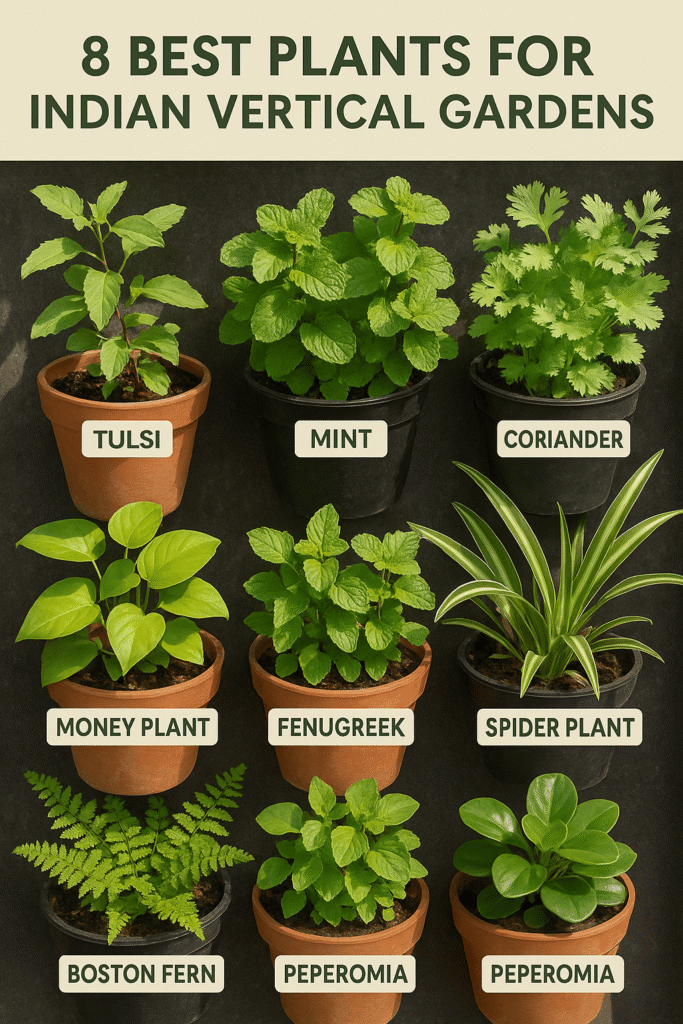
I’ve tested over 25 varieties. Here’s the honest truth about what thrives and what dies in Indian vertical gardens:
The Champions (Never Failed Me):
Tulsi: Grows aggressively in heat, has sacred significance, natural mosquito repellent. Plant once, harvest forever.
Pudina (Mint): Ready to harvest in 3 weeks, loves our climate, but keep it contained or it’ll take over everything.
Dhania (Coriander): Fresh leaves for cooking, seeds for spices, succession plant every 2 weeks for continuous harvest.
Green chilies: Essential for Indian cooking, produces continuously, and actually prefer our heat.
Cherry tomatoes: Compact variety perfect for containers, continuous harvest through the season.
Methi (Fenugreek): Both leaves and seeds are useful, with cut-and-come-again harvesting.
Marigold: Natural pest deterrent, blooms continuously, adds color.
The complete care guide: For detailed growing instructions and seasonal care tips, check our comprehensive 45°C proof plants for Indian terraces guide.
Plants I learned to avoid:
Foreign varieties that look pretty in photos but can’t handle Indian conditions. Expensive lesson learned.
High-maintenance plants require controlled temperatures. Save these for when you have experience.
Anything that spreads aggressively without containment (looking at you, unrestricted mint).
Watering Simplified for Indian Climate
The Reality of Indian Conditions
Finger test: Push your finger 1-2 inches into the soil before watering. Our clay-heavy local soils retain moisture differently from Western potting mixes.
Timing matters: 6-7 AM watering prevents fungal issues that develop in our high humidity if you water in the evenings.
Seasonal adjustments:
- Summer: Daily watering before 8 AM, period
- Monsoon: Every 2-3 days, always check for waterlogging first
- Winter: Every alternate day, let the topsoil dry between waterings
DIY Irrigation for ₹150
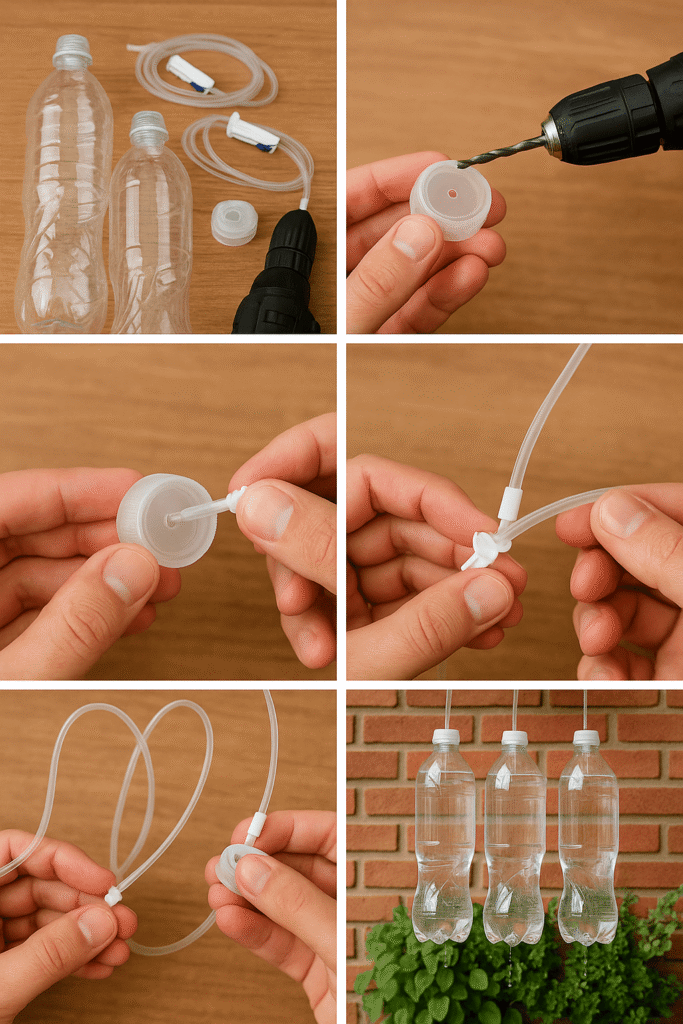
This simple system has been a game-changer for busy weekdays and weekend trips:
Materials:
- 2-liter plastic bottles (₹0 – use what you have)
- Medical IV tubing from pharmacy (₹20 per meter)
- Tube clamps for flow control (₹30 for pack of 10)
Setup: Drill small holes in bottle caps, thread tubing through, position bottles above plants, adjust flow with clamps.
For automated setups and power-cut solutions, our automated irrigation solutions for Indian apartments cover advanced techniques using local materials.
Mistakes that killed my plants:
- Overwatering during the monsoon (more deadly than summer heat)
- Underwatering when temperatures hit 42°C+
- Not adjusting for seasonal changes
Design Ideas for Different Budgets
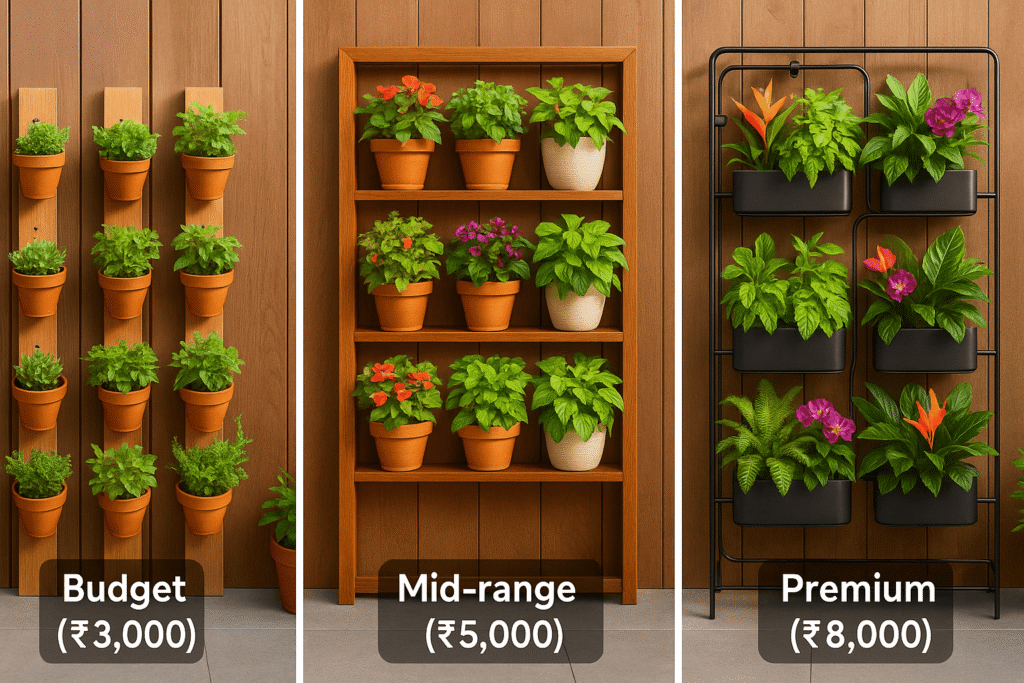
Budget style (Under ₹3,000): Colorful plastic crates, bamboo supports, bright paint for personality. Functional over form, but surprisingly effective.
Middle-class approach (₹4,000-7,000): Matching metal planters, semi-automated watering, clean lines that pass society inspection.
Premium setup (₹8,000+): Designer containers, built-in water reservoirs, impressive enough to feature in housing society newsletters.
The truth? My budget setup performs just as well as the premium versions. Choose based on your aesthetic preferences and social requirements, not plant performance.
Maintenance Reality Check
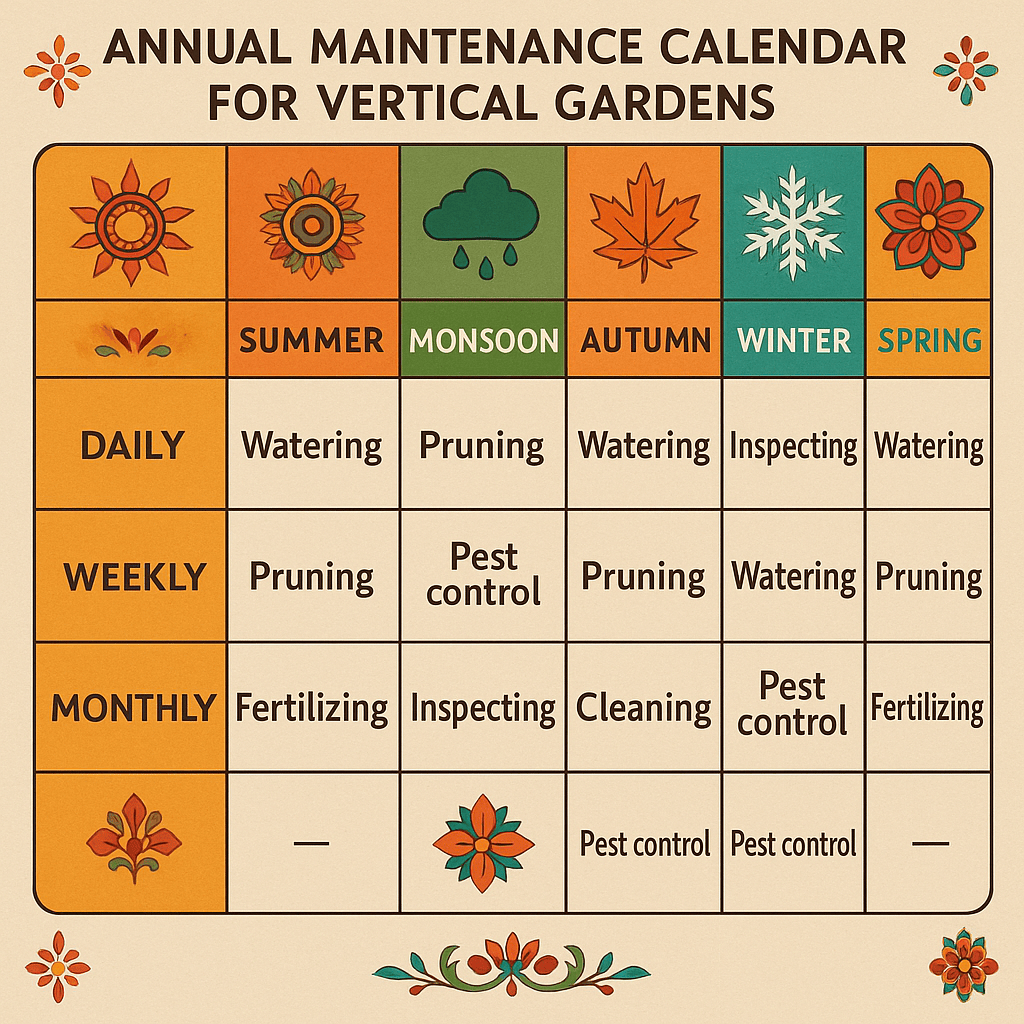
Daily (Honestly, 5 minutes max)
Summer: Morning plant check and watering before heading to work
Monsoon: Quick drainage check, look for fungal issues
Winter: Minimal care, reduced watering
Weekly (15 minutes on Sunday morning)
- Thorough watering session
- Harvest ready vegetables and herbs
- Quick pest inspection
Monthly (30 minutes)
- Feed with liquid fertilizer
- Prune overgrown plants
- Plan next plantings
The maintenance is way less intimidating than it sounds. Most days, it’s just watering while having morning chai.
For season-specific maintenance schedules, our comprehensive Indian climate garden care guide breaks down exactly what to do when.
Common Beginner Mistakes (I Made Them All)
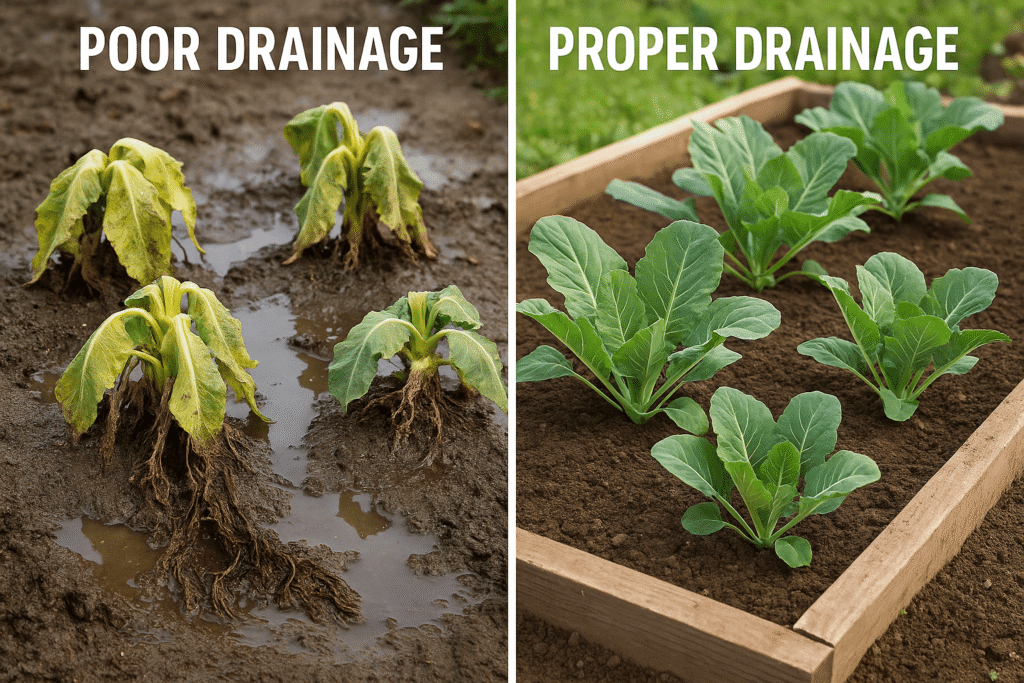
- Choosing Instagram-pretty plants instead of climate-appropriate ones
- Ignoring drainage because “it’s just plants”
- Planting summer vegetables in winter because I was excited
- Overwatering during humidity spikes
- Not informing building management and dealing with complaints later
- Starting too big and getting overwhelmed
- Buying expensive tools before learning basic techniques
Each mistake cost me time, money, or both. Learn from my experience and check our guide to low-maintenance terrace gardening featuring foolproof varieties that literally refuse to die in Indian conditions.
Your Action Plan
This Weekend’s Tasks
✓ Spend one day tracking sunlight patterns on your balcony
✓ Get verbal okay from building management
✓ Visit local nursery for materials (Sunday mornings are best)
✓ Set up basic 3-container system
✓ Plant tulsi, pudina, and one flowering plant
✓ Set morning watering reminders on phone
Start now: Your 2-hour weekend project becomes a 30-day transformation. I’ve watched complete beginners harvest fresh herbs within a month.
The satisfaction of adding homegrown pudina to evening chai or fresh green chilies to dinner is genuinely life-changing. It sounds dramatic, but it’s true.
🎁 Free Resources Just for You:
📥 7-Day Setup Checklist PDF – Shopping lists, daily tasks, troubleshooting tips
📱 Seasonal Care Calendar – Month-by-month care guide for Indian climate
🌱 Plant Selection Worksheet – Match plants to your specific balcony conditions
💬 WhatsApp Community Access – Daily tips and 2,000+ Indian apartment gardeners
Comment below with your city and balcony size – I personally respond with customized advice!
Ready for advanced techniques? Our complete advanced Mumbai apartment vertical garden techniques guide covers scaling up, automation, and year-round productivity.
Quick Answers to Common Questions
Q: How much does this really cost to start?
₹2,200-5,400 for complete setup. I recommend starting with ₹3,900 for good-quality basics. Local markets in Mumbai, Delhi, Bangalore offer 40-50% savings over online prices.
Q: Which container size for Indian plants?
6-8 inches deep for herbs like tulsi and pudina. 10-12 inches for vegetables like tomatoes and chilies. Anything smaller than 4 inches dries out too fast in our heat.
Q: What if I have no balcony?
Windowsill planters work great for herbs. Many 1BHK residents successfully grow kitchen herbs on bathroom or kitchen windows with 4+ hours light.
Q: Easiest plants for absolute beginners?
Start with tulsi, pudina, dhania, and marigold. These handle heat, humidity, pollution, and beginner mistakes better than anything else. For a complete list of 15+ beginner-friendly, heat-tolerant plants, check our comprehensive guide to low-maintenance terrace plants that thrive on minimal care.
Q: Can renters do this?
Absolutely. Portable systems don’t damage walls. I’ve helped 50+ renters set up successful gardens. Just inform your landlord as a courtesy.
About Zaid Ansari
I’m just a regular guy who figured out apartment gardening the hard way so you don’t have to. Three years, 200+ people helped, countless mistakes made and learned from. Based in Mumbai, passionate about making gardening accessible for Indian apartment dwellers.
Follow the journey: @flatgardening on Instagram for daily tips, failures, and victories from real Indian balconies.